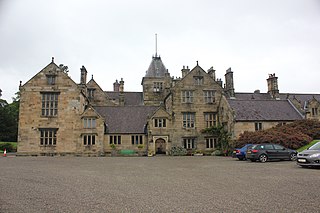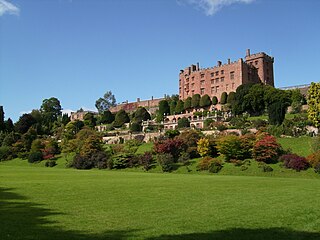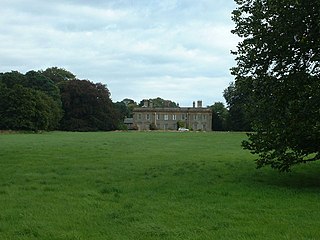
Gregynog is a large country mansion in the village of Tregynon, 4 miles (6.4 km) northwest of Newtown in the old county of Montgomeryshire, now Powys in mid Wales. There has been a settlement on the site since the twelfth century. From the fifteenth to the nineteenth century it was the home of the Blayney and Hanbury-Tracy families. In 1960 it was transferred to the University of Wales as a conference and study centre by Margaret Davies, granddaughter of the nineteenth century industrial magnate and philanthropist, David Davies 'Top Sawyer' of Llandinam.

Aberffraw is a village and community on the south west coast of the Isle of Anglesey, in Wales, by the west bank of the Afon Ffraw. The community includes Soar and Dothan. Located near the A4080 and the nearest rail station is Bodorgan.

Llangedwyn is a village in Montgomeryshire, Powys, Wales. The population of the community at the 2011 census was 402. The community includes the hamlet of Pen-y-bont Llanerch Emrys.
The Tapps, later Tapps-Gervis, later Tapps-Gervis-Meyrick Baronetcy, of Hinton Admiral in the County of Hampshire, is a title in the Baronetage of Great Britain. It was created on 28 July 1791 for the landowner and developer George Tapps. The second Baronet sat as Member of Parliament for New Romney and Christchurch. He assumed in 1835 the additional surname of Gervis. The third Baronet was high sheriff of Anglesey in 1878. He assumed in 1876 by Royal licence the additional surname of Meyrick according to the will of Owen Fuller Meyrick, a relative on his mother's side, from whom he inherited the Bodorgan estate on the Isle of Anglesey. The fourth Baronet was high sheriff of Hampshire in 1900. The fifth Baronet was high sheriff of Anglesey in 1939.
Pentre Berw is a small village located on the island of Anglesey in north Wales. It lies about 2 miles (3.2 km) south of the county town of Llangefni, and next to Gaerwen.

Bodorgan is a village and community on the Isle of Anglesey, Wales, United Kingdom. According to the 2001 Census, there were 1,503 residents in the now former electoral ward, 72.7% of them being able to speak Welsh. This increased to 1,704 at the 2011 Census but only 67.72% of this increased population were Welsh speakers.
Plas Gwyn is an area in the community of Pentraeth, Anglesey, Wales, which is 131.8 miles (212 km) from Cardiff and 211.2 miles (339.8 km) from London.

Mostyn Hall is a large house standing in 25 acres of garden near the village of Mostyn, Flintshire, Wales. It is designated by Cadw as a Grade I listed building.

The Cadw/ICOMOS Register of Parks and Gardens of Special Historic Interest in Wales is a heritage register of significant historic parks and gardens in Wales. It is maintained by Cadw, the historic environment service of the Welsh Government and was given statutory status in 2022.

LlanvihangelCourt, Llanvihangel Crucorney, is a Tudor country house in Monmouthshire, Wales. The architectural historian John Newman, in his Gwent/Monmouthshire volume of The Buildings of Wales series described the court as "the most impressive and richly decorated house of around 1600 in Monmouthshire". The origins of the house are medieval, with a traditional date of construction of 1471. The building was given its present appearance by a substantial enlargement and re-casing of circa 1600 by Rhys Morgan, of the family of the original owners. In the very early 17th century it was owned briefly by Edward Somerset, 4th Earl of Worcester.

High Glanau is a country house and Grade II* listed building within the community of Cwmcarvan, Monmouthshire, Wales. It is located about 5 miles (8.0 km) south-west of Monmouth, and 1.5 miles (2.4 km) north of Trellech, adjoining the B4293 road and with views westwards over the Vale of Usk. Commissioned by Henry Avray Tipping and designed by Eric Francis, it is particularly noted for its gardens which are listed at Grade II* on the Cadw/ICOMOS Register of Parks and Gardens of Special Historic Interest in Wales.

In the United Kingdom, the term listed building refers to a building or other structure officially designated as being of special architectural, historical, or cultural significance; Grade II* structures are those considered to be "particularly important buildings of more than special interest". Listing was begun by a provision in the Town and Country Planning Act 1947. Once listed, strict limitations are imposed on the modifications allowed to a building's structure or fittings. In Wales, the authority for listing under the Planning Act 1990 rests with Cadw.

Moynes Court is a Grade II* listed building in the village of Mathern, Monmouthshire, Wales, about 3 miles (4.8 km) south west of Chepstow. An earlier building was rebuilt as a private residence by Francis Godwin, Bishop of Llandaff, in about 1609/10, and much of the building remains from that period. Its grounds contain earthworks thought to be the foundations of an earlier moated manor house. The gatehouse to the court has a separate Grade II* listing. The garden at the court is on the Cadw/ICOMOS Register of Parks and Gardens of Special Historic Interest in Wales.

Chateau Rhianfa is a Grade II*-listed former house which has been converted into a hotel. Its gardens are listed as Grade II* on the Cadw/ICOMOS Register of Parks and Gardens of Special Historic Interest in Wales.

Mounton House, Mounton, Monmouthshire, Wales, is the last major country house built in the county, constructed between 1910 and 1912 by the architect and writer Henry Avray Tipping for himself. Formerly a school, which has now relocated to the grounds, the house has been divided into apartments. It is a Grade II* listed building. The surrounding park is on the Cadw/ICOMOS Register of Parks and Gardens of Special Historic Interest in Wales.

Orielton is a historic country house near Hundleton in Pembrokeshire, Wales. It has been used as a field studies centre for environmental sciences but was put on sale in early 2022.

Leeswood Hall is a country house in Leeswood, Flintshire, Wales. Dating from 1742, it was built for George Wynne, the design being attributed to Francis Smith. Construction reputedly cost £40,000. The hall is a Grade II* listed building. To the northwest of the hall stand the White Gates, which have their own Grade I listing. The gates terminate the view from the hall across the lawns, an early and rare example of 18th century parkland design by Stephen Switzer, and a Grade I listed landscape of national significance.

Kemeys Manor, Langstone, Newport, Wales, is a manor house dating from the 13th century. The family that built it was established in South Wales in the Middle Ages by Edward, Lord of Kemeys and the manor was held by his descendants until the 18th century. The building was greatly enlarged in the 16th and 17th centuries and comprises a tower, hall and attached ranges. Kemeys is a Grade II* listed building. A barn to the north of the house, and Kemeys Folly to the south, are both listed at Grade II. The park surrounding the house is listed Grade II on the Cadw/ICOMOS Register of Parks and Gardens of Special Historic Interest in Wales. The manor and the folly remain private residences and are not open to the public.

The Isle of Anglesey, a principal area off the north-west coast of Wales, includes the islands of Anglesey, Holy Island and some islets and skerries. It covers an area of 711 km2 (275 sq mi) and in 2021 the population was approximately 68,900.

Bertholey House, is a country house near the village of Llantrisant, in Monmouthshire, Wales. A Tudor house originally stood on the site, the home of the Kemeys family. In the 1830s, a new mansion was built, in a Neoclassical style, for Colthurst Bateman. This house was almost completely destroyed in a fire in 1905. From 1999, the mansion was restored and is again a private home. The gardens and grounds are listed on the Cadw/ICOMOS Register of Parks and Gardens of Special Historic Interest in Wales.



















